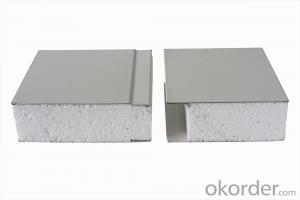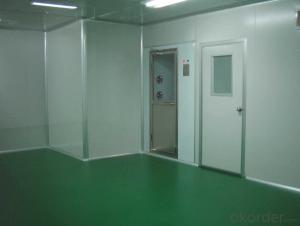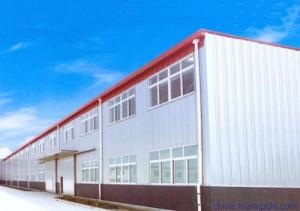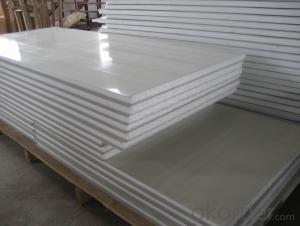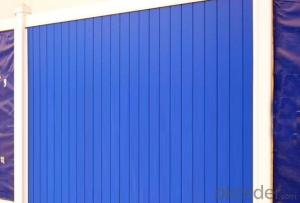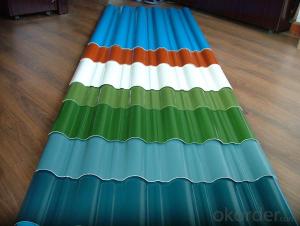Prepainted Steel Coil PPGI GI of CNBM in China
- Loading Port:
- China main port
- Payment Terms:
- TT OR LC
- Min Order Qty:
- 1 m.t.
- Supply Capability:
- 1 m.t./month
OKorder Service Pledge
Quality Product, Order Online Tracking, Timely Delivery
OKorder Financial Service
Credit Rating, Credit Services, Credit Purchasing
You Might Also Like
Quick Details
| Standard: | AISI,ASTM,BS,DIN,GB,JIS | Thickness: | 0.12 - 2.00 mm | Place of Origin: | Tianjin China (Mainland) |
| Brand Name: | cnbm | Model Number: | DX51D ,SGCC,SGCH | Type: | Steel Coil |
| Technique: | Hot Rolled | Surface Treatment: | Galvanized | Application: | Construction |
| Special Use: | High-strength Steel Plate | Width: | 702mm- 1250mm | Length: | as your requirement |
| Certification: | BV,SGS,TUV |
Packaging & Delivery
| Packaging Detail: | standard sea-worthy package or as customers' requirement |
| Delivery Detail: | generally 10-25 days or as customers' quantity |
Specifications
1.reasonable price
2.reliable quality
3.fast shipment
4.huge production capacity
5.BV,SGS and TUV certificates
The details:
| Base Material | Hot Dipped Galvanized Steel |
| Grade | ASTM,DX51D,SGCC,CGCC and CGCH. |
| Thickness | 0.12~2.0mm |
| Coil width | 600~1250mm |
| Coil ID | 508- 610mm |
| Coil weight | 3~7 tons |
| Zinc coating | 40~275 g/m2 |
| Painting | Top and bottom :15~25 microns |
| Back :5~8 microns | |
| Color | RAL system as per customers requirement |
| Package | Export seaworthy packing |
| MOQ | 25 tons |
- Q:What are the different types of coatings available for steel sheets?
- There are several types of coatings available for steel sheets, including galvanized coatings, zinc coatings, tin coatings, aluminum coatings, and polymer coatings. Each type of coating offers unique properties and benefits, such as corrosion resistance, improved durability, enhanced aesthetics, and increased protection against environmental factors. The choice of coating depends on the specific application and desired characteristics of the steel sheets.
- Q:What is the difference between galvanized and non-galvanized steel sheets?
- The primary difference between galvanized and non-galvanized steel sheets lies in their ability to resist corrosion. Galvanized steel sheets have a layer of zinc coating that acts as a protective barrier against rust and other forms of corrosion. This zinc coating not only adds durability and longevity to the sheets, but also makes them highly resistant to weathering and moisture exposure. On the other hand, non-galvanized steel sheets lack this zinc coating, making them more susceptible to rust and corrosion. Without the protective layer, non-galvanized steel sheets may corrode when exposed to moisture or harsh environmental conditions. In addition to their resistance to corrosion, the appearance of galvanized and non-galvanized steel sheets also differs. Galvanized steel sheets have a distinct silver-gray finish due to the zinc coating, giving them a more visually appealing look. In contrast, non-galvanized steel sheets have a plain, matte appearance. Considering cost, galvanized steel sheets are generally more expensive than non-galvanized ones. This is because the zinc coating adds an extra layer of protection and enhances the overall quality of the sheets. In summary, the main distinction between galvanized and non-galvanized steel sheets lies in their resistance to corrosion, appearance, and cost. Galvanized steel sheets offer superior protection against rust and corrosion, have a more attractive appearance, but come at a higher cost compared to non-galvanized steel sheets.
- Q:What is the average lifespan of steel sheets used for roofing?
- The average lifespan of steel sheets used for roofing can vary depending on several factors such as the quality of the steel, the thickness of the sheets, the climate conditions, and proper maintenance. However, on average, steel sheets used for roofing can last anywhere from 30 to 50 years or more with proper installation and regular upkeep.
- Q:Are steel sheets suitable for food processing industries?
- Yes, steel sheets are suitable for food processing industries. Steel is a durable and hygienic material that is resistant to corrosion, heat, and chemicals, making it ideal for food processing equipment and surfaces. It is also easy to clean and maintain, ensuring food safety standards are met.
- Q:Can steel sheets be used for heat transfer applications?
- Yes, steel sheets can be used for heat transfer applications. Steel is a good conductor of heat, which means it can efficiently transfer heat from one surface to another. Steel sheets are often used in various heat transfer applications, such as heat exchangers, HVAC systems, and industrial machinery. They are known for their high thermal conductivity and durability, making them suitable for transferring heat in a wide range of industries and applications. Additionally, steel sheets can be easily fabricated and formed into different shapes and sizes, allowing for customized heat transfer solutions.
- Q:What is the difference between zinc-coated and zinc-aluminum coated steel sheets?
- Zinc-coated and zinc-aluminum coated steel sheets are both types of steel that have been treated with a protective layer of zinc. However, there are some differences between the two processes that result in different characteristics and performance. Zinc-coated steel sheets, also known as galvanized steel sheets, are created by immersing the steel sheets in a bath of molten zinc. This process forms a layer of pure zinc on the surface of the steel, creating a barrier that protects the steel from corrosion. The zinc layer is typically applied evenly across the entire surface of the steel sheet. On the other hand, zinc-aluminum coated steel sheets, also known as galvalume or Aluzinc steel sheets, are created by coating the steel sheets with a mixture of zinc and aluminum. This coating is applied using a hot-dip process, similar to that used for zinc-coated steel sheets. The presence of aluminum in the coating provides enhanced corrosion resistance compared to pure zinc coatings. The key difference between zinc-coated and zinc-aluminum coated steel sheets lies in their performance and durability. Zinc-coated steel sheets are effective in protecting the steel from corrosion in most atmospheric environments. However, in more aggressive or severe environments, such as those with high humidity or exposure to saltwater, zinc-coated steel may not provide sufficient protection and can corrode over time. Zinc-aluminum coated steel sheets, on the other hand, offer superior corrosion resistance due to the presence of aluminum in the coating. The aluminum acts as a sacrificial anode, which means it corrodes preferentially to the steel, protecting it from corrosion. This makes zinc-aluminum coated steel sheets more suitable for environments where corrosion is a significant concern, such as coastal areas or industrial settings. In summary, while both zinc-coated and zinc-aluminum coated steel sheets provide a protective layer of zinc, zinc-aluminum coated sheets offer improved corrosion resistance due to the presence of aluminum. Therefore, zinc-aluminum coated steel sheets are generally preferred in more aggressive or corrosive environments, while zinc-coated steel sheets are suitable for most atmospheric conditions.
- Q:What are the different sizes of steel sheets available?
- Various sizes of steel sheets are readily available to cater to a range of applications and industries. The dimensions of steel sheets can vary depending on factors such as thickness, width, and length. In terms of thickness, steel sheets are commonly found in gauges ranging from 7 to 30. The gauge number indicates the thickness, with higher numbers representing thinner sheets. Thinner sheets, like those with a gauge of 30, are often used for flexible applications. On the other hand, thicker sheets, like those with a gauge of 7, are typically employed for heavy-duty applications that require strength and durability. When it comes to width, steel sheets are offered in a variety of choices. The most frequently seen widths include 36 inches, 48 inches, and 60 inches. Customized widths can also be obtained to meet specific requirements. Regarding length, standard lengths for steel sheets are typically 96 inches and 120 inches. These lengths are widely used in various industries. However, similar to width, length can also be customized to suit specific needs. It is important to note that the availability of different sizes of steel sheets may vary depending on the supplier and the specific grade of steel used. It is advisable to consult with a steel sheet supplier or manufacturer to determine the exact sizes available for a particular application.
- Q:What is the difference between coated and uncoated steel sheets?
- The primary distinction between coated and uncoated steel sheets lies in their protective layer and surface finish. Coated steel sheets, also referred to as galvanized steel sheets, possess a layer of zinc coating to prevent corrosion and enhance durability. This zinc coating serves as a sacrificial layer, shielding the underlying steel from rust and other forms of damage. Furthermore, coated steel sheets exhibit a more polished and smoother appearance. In contrast, uncoated steel sheets do not undergo any treatment involving a protective layer. Consequently, they are more prone to corrosion, particularly when exposed to moisture or chemicals. Uncoated steel sheets are commonly utilized in situations where corrosion resistance is not a significant concern, such as in construction projects where the steel will be covered or safeguarded in some manner. Regarding cost, coated steel sheets are generally pricier than uncoated steel sheets due to the additional manufacturing process required to apply the zinc coating. Nevertheless, the increased cost is justified by the improved durability and extended lifespan of coated steel sheets. To summarize, the key disparity between coated and uncoated steel sheets lies in the presence of a protective layer. Coated steel sheets offer superior corrosion resistance and possess a smoother appearance, while uncoated steel sheets are more susceptible to corrosion and possess a rougher surface finish.
- Q:How do you prevent galvanic corrosion when using steel sheets in contact with water?
- To prevent galvanic corrosion when using steel sheets in contact with water, you can employ several measures. One effective approach is to apply a protective coating or paint on the steel sheets, acting as a barrier between the steel and water. Another option is to use corrosion-resistant steel alloys, such as stainless steel, which have inherent resistance to galvanic corrosion. Additionally, isolating the steel sheets from other dissimilar metals or using corrosion inhibitors can help prevent galvanic corrosion. Regular inspection, maintenance, and prompt repair of any coating damages are also crucial to avoid the onset of corrosion.
- Q:How do steel sheets perform in terms of sound insulation?
- Steel sheets have limited sound insulation capabilities. While they can help reduce some high-frequency noise, they are not as effective as other materials specifically designed for soundproofing, such as acoustic panels or soundproofing foams.
1. Manufacturer Overview |
|
|---|---|
| Location | |
| Year Established | |
| Annual Output Value | |
| Main Markets | |
| Company Certifications | |
2. Manufacturer Certificates |
|
|---|---|
| a) Certification Name | |
| Range | |
| Reference | |
| Validity Period | |
3. Manufacturer Capability |
|
|---|---|
| a)Trade Capacity | |
| Nearest Port | |
| Export Percentage | |
| No.of Employees in Trade Department | |
| Language Spoken: | |
| b)Factory Information | |
| Factory Size: | |
| No. of Production Lines | |
| Contract Manufacturing | |
| Product Price Range | |
Send your message to us
Prepainted Steel Coil PPGI GI of CNBM in China
- Loading Port:
- China main port
- Payment Terms:
- TT OR LC
- Min Order Qty:
- 1 m.t.
- Supply Capability:
- 1 m.t./month
OKorder Service Pledge
Quality Product, Order Online Tracking, Timely Delivery
OKorder Financial Service
Credit Rating, Credit Services, Credit Purchasing
Similar products
New products
Hot products
Related keywords
